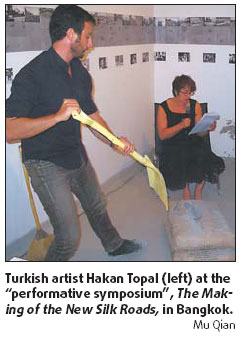When contemporary arts practitioners from neighboring Asian countries, such as China, Kyrgyzstan and Afghanistan, met at a recent international symposium, they found they hardly knew anything about contemporary arts in one another's countries.
"I've participated in exhibitions in many European countries, but I've never been to China and know very little about Chinese artists," said Kyrgyz artist Shaarbek Amankul, during the symposium, The Making of the New Silk Roads, held in Bangkok from Aug 28 to 30.
"Kyrgyzstan and China are neighboring countries. I really hope we can know more about each other."

Chinese architect and designer Jiang Jun, another participant, believes Chinese people have studied Western cultures without looking at other developing Asian countries.
"I'm looking forward to learning more about the cultures and arts of other Asian countries and discovering their different ways of thinking," he said.
Both Amankul and Jiang met many artists and scholars from various Asian countries and regions at the symposium, which examined the continent's latest cultural trends. European and Latin American countries were also represented.
"The idea of the symposium is to discuss and reflect on the dynamic, ongoing echoes of the ancient trading route, the Silk Road, and its multiple dimensions, and to reassess the complex interconnections within Asia's cultural and artistic spectrum at the beginning of the 21st century," said Davide Quadrio, director of Arthub, a Hong Kong-based non-profit foundation that organized the symposium.
The historical Silk Road is an extensive and interconnected network of trade routes across the Eurasian continent linking East, South and West Asia with the Mediterranean world, as well as North and Northeast Africa, and Europe. It started before the time of Jesus and declined after the late Middle Ages, as sea trade increased.
"The Silk Road is actually a Western, colonialist brand from the 19th century," said Quadrio, who is Italian but has lived in Shanghai for nearly 20 years and founded BizArt, one of Shanghai's first contemporary art centers.
"What interests me is the possibility now for those Asian countries to have an independent discourse that is not based on Western ideas."
Although contemporary Chinese art has been widely discussed by the global community in recent years, Quadrio believes many Chinese artists have been representing China using Western symbols they don't fully understand.
But Jiang contends traditional Chinese culture has begun to revive this decade after its decline in the 1980s and '90s.
"As Western contemporary art goes into a bottleneck, Chinese culture may provide an alternative for artists - for example, its non-aggressive attitude," he said.
At The Making of the New Silk Roads, which Quadrio defined as a "performative symposium", participants gave presentations and performances reflecting their various cultures.
Hong Kong social curator Howard Chan's Community Museum Project presented a community-driven scene of Hong Kong through an inspection of common people's daily necessities. Afghan artist and professor Rahraw Omarzad shared his insights on how contemporary art can develop in a traditional and war-torn country like Afghanistan.
The works of four artists from Vietnam and Cambodia were also presented as part a project called the Ho Chi Minh Trail. The works began with the sharing of three Cambodian perspectives on China based on interviews with their local communities, revealing the complexity of nationhood, cultural memory and economy.
"I hope that through the project there will be more critical understanding of historical relationships between China, Vietnam, Cambodia and Laos, and of how they influenced the culture and thinking within this part of the world," said Zoe Butt, International Programs director of Beijing-based global arts organization Long March Project, which initiated Ho Chi Minh Trail.
Quadrio believes: "All the participants have been doing interesting projects in different contexts. Exchanges will open possibilities of thinking outside of the box for them."
(China Daily September 15, 2009)